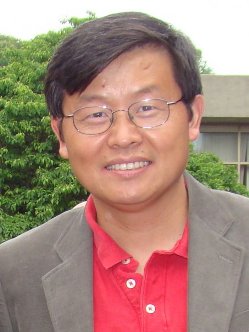中关村论坛 248
题目: Resistive-pulse sensing of filamentous fdvirus using solid-state nanopores
时间: 2012年10月10日 10:00
地点: 中科院物理所D楼212报告厅
报告人: Xinsheng Ling
Physics Department, BrownUniversity, Providence, RI 02912 USA
Abstract:
Solid-state nanopores have emerged as one of the most promising nanobiotechnologies. Here I will give a general update on this technology and describe an experimental study of resistive-pulse sensing of filamentous fdviruses with solid-state nanopores. Two dominant types of resistive-pulse signals are observed. The first type is of a square-like shape, the expected result of electric field driven translocation of a rigid rod. The second type exhibits a clear pre-translocation partial blockage of the nanopore followed by a type-I translocation. The measured probability density of type-II events increases strongly with applied voltage. A non-equilibrium model is proposed to describe the capturing processes of fdviruses into a nanopore. In contrast to DNA molecules, which are extremely flexible and can undergo folded configuration during translocation, the rigidity of fdvirus particles makes folded configuration impossible. Instead, a dominant kinetic process of fd translocation is through a metastable state where the fdviruses are captured at the entrance of the pore with a horizontal direction or at an oblique angle. After extracting the translocation times for type-I and type-II events, we determined the translocation velocity v as a function of applied electric field E. It is found that the velocity v is a nonlinear function of the electric field E, and can be described by a formula: v = m(1)E + m(3)E3. In addition to the first linear Smoluchowski term, the second term with cubic dependence on E has been described as a kinetic Stotz-Wien effect caused by the polarization of the Debye counter ion cloud. The discovery of the Stotz-Wien effect in fd translocation in solid-state nanopores opens door for a possible biosensing technology since the cubic-term coefficient m(3) is determined by the surface conductivity of the virus which may be sensitive to surface protein structures on a virus. This work was done in collaboration with Liping Liu and Anna Lu.
个人简介:
Xinsheng Ling is a 1984 graduate of Wuhan University, he received his M.S. from the Institute of Metal Research of the Chinese Academy of Sciences in Shengyang in 1987, and his Ph.D. from the University of Connecticut in 1992. He has done postdoctoral research at Yale University (1992-1994) and the NEC Research Institute at Princeton (1994-1996). Most recently he was a visiting professor at Delft University of Technology in the Netherlands from 2002-2003. He was an A.P. Sloan Fellow from 1998-2001 and a J.S. Guggenheim Fellow from 2002-2003. He was elected a Fellow of the American Physical Society in 2005 for the discovery of the peak effect in high-Tc superconductors (in 1991) and for the pioneering studies in point and topological defects in two-dimensional colloidal crystals (in 2001), and for co-inventing the TEM-drilling technique for nanopore fabrication (2003).
联系人:戴希 研究员(82648057)
报告邀请人: 丁洪 研究员 (82649200)
李明 研究员(82649058)

